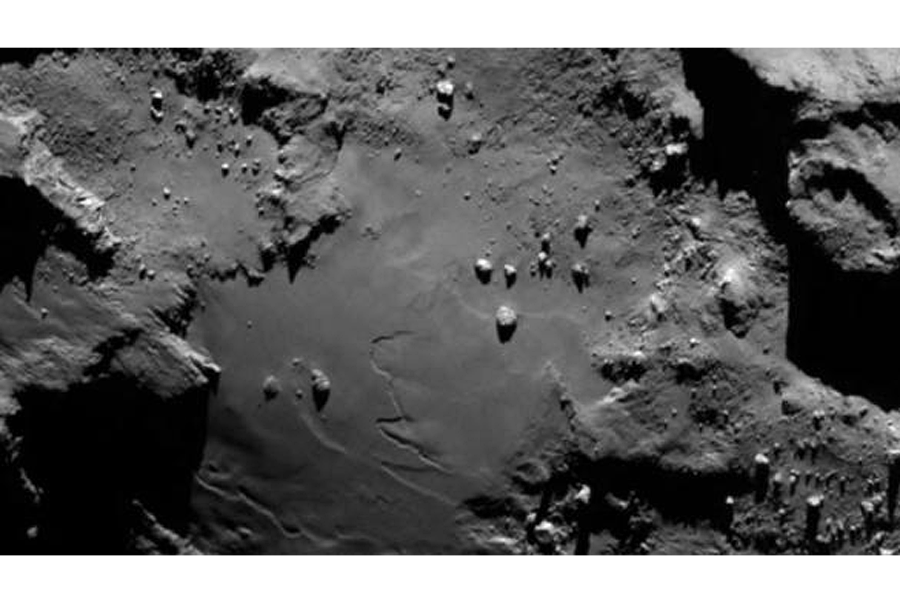Microbes on a comet?! Why scientists are skeptical
Loading...
Sen—Two astronomers made the controversial claim today to have detected potential evidence for life on the comet being studied by Europe’s Rosetta space probe. But their report was immediately met with general skepticism.
Dr Max Wallis, of Cardiff University, says Comet 67P/Churyumov-Gerasimenko could be a more friendly environment for simple organisms than the Arctic and Antarctic on Earth where hardy microbes have been found.
Dr Wallis, and colleague Professor Chandra Wickramasinghe, Director of the Buckingham Centre for Astrobiology, say that features on the comet’s surface appear to have been shaped by micro-organisms. Dr Wallis explained their study at the National Astronomy Meeting (NAM) at Llandudno, Wales.
They say their radical explanation is supported by images from orbiter Rosetta and data collected by its little lander Philae. However, the extraordinary claims have been met with ridicule by mainstream scientists, many of whom are surprised it made it onto the science programme of this major conference, organised by the Royal Astronomical Society.
Images of Comet 67P’s twin-lobed structure shows a black crust covering ice, and large smooth plains, flat-bottomed craters and with huge boulders littering the surface. The crater floors are said to be areas of water that has refrozen and is covered with organic debris. Grooves have been produced where the nucleus has cracked under the strains of constant flexing.
Dr Wallis and Professor Wickramasinghe believe these features can be explained by the regular warming of the comet, and its effect on a mix of ice and organic material, during its elliptical orbit of the Sun. They say this warming can support the existence of active micro-organisms which could inhabit cracks in the comet’s ice and snow. Organisms containing anti-freeze salts would remain active in temperatures as low as -40°, they say.
Further evidence for comet life, according to the pair, is Philae’s detection of an abundant amount of complex organic molecules on 67P’s surface and in infrared images taken by Rosetta’s cameras. Dr Wallis said in a statement: “Rosetta has already shown that the comet is not to be seen as a deep-frozen inactive body, but supports geological processes and could be more hospitable to micro-life than our Arctic and Antarctic regions.”
The start of the abstract, or summary, of the presentation reads: “Despite the comet’s very black crust, Rosetta’s remarkable images show several indicators of an underlying icy morphology. Comet 67P displays smooth, planar ‘seas’ (the largest 600mx 800m) and flat-bottomed craters, both features seen also on comet Tempel-1. Comet 67P’s surface is peppered with mega-boulders (10-70km) like comet Hartley-2, while parallel furrowed terrain appears as a new ice feature.
“The largest sea (Cheops Sea, 600 x 800m) curves around one lobe of the 4km diameter comet, and the crater lakes extending to ~150m across are re-frozen bodies of water overlain with organic-rich debris (sublimation lag) of order 10 cm. The parallel furrows relate to flexing of the asymmetric and spinning two-lobe body, which generates fractures in an underlying body of ice. The mega-boulders are hypothesised to arise from bolide impacts into ice.”
It adds: “Increasing rates of gassing as Rosetta follows comet 67P around its 1.3 AU perihelion will hopefully reveal the activation of possible micro-organisms as well as the nature and prevalence of near-surface ices.”
The comet session at NAM was run by Dr Colin Snodgrass, of the UK’s Open University at Milton Keynes. He defended the contribution on Twitter, saying: “As the session chair, it is there as the abstract is perfectly reasonable. We don’t control PR though.”
Rosetta chief scientist Matt Taylor tweeted the reply: “Indeed, we should allow things to be put up there for discussion.”
Another leading comet scientist, Professor Alan Fitzsimmons, of Queens University, Belfast, tweeted that organisers should not stifle ideas. But he believes the research is flawed. He told Sen: “Scientists are rightly fascinated by the search for life elsewhere, and the possibility of the delivery of life to Earth from elsewhere remains an intriguing line of enquiry. However all measurements from Rosetta or by Earth-based telescopes on comets can be explained by much simpler chemical and physical processes than involving extra-trerrestrial life.
“These scientists seem to have forgotten Carl Sagan’s maxim that ‘extraordinary claims require extraordinary evidence’. They don’t have it.”
Sen was at Dr Wallis’s presentation. He got a polite reception from his fellow scientists as he talked of “potential biofossils” and “potential biomarkers”, concluding “if there is any active biology in the comet, we’d hope to detect it.” But one comet expert pointedly commented that there would be other theories.
Related Links:
Comet's secrets are unlocked by the power of ALMA
Philae finds life's building blocks on comet's surface
Original story from Sen. © 2015 Sen TV Limited. All rights reserved. This material may not be published, broadcast, rewritten or redistributed. For more space news visit Sen.com and follow @sen on Twitter.







